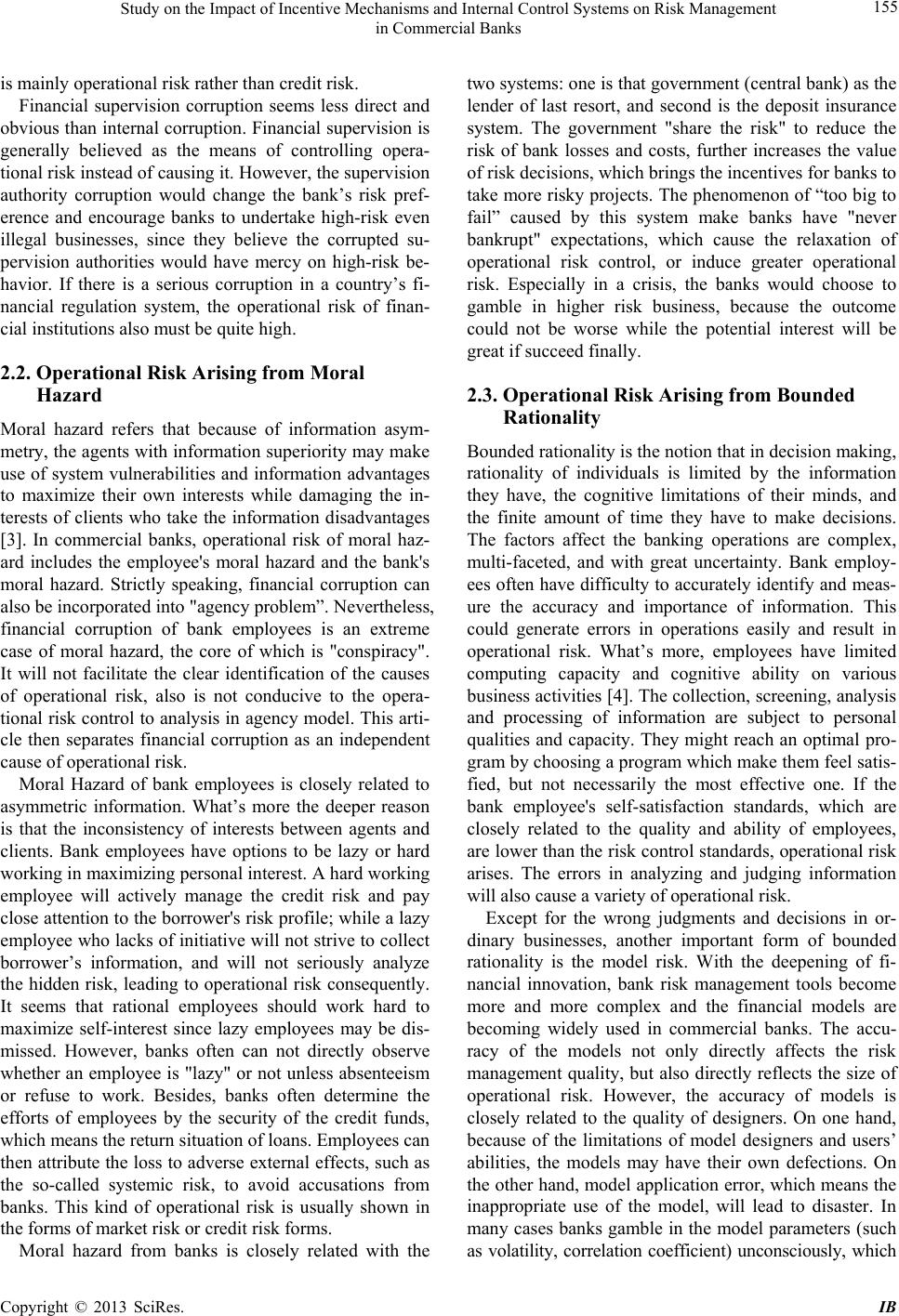
Study on the Impact of Incentive Mechanisms and Internal Control Systems on Risk Management
in Commercial Banks 155
is mainly operational risk rather than credit risk.
Financial supervision corruption seems less direct and
obvious than in ternal corruption. Financial supervision is
generally believed as the means of controlling opera-
tional risk instead of causing it. However, the superv ision
authority corruption would change the bank’s risk pref-
erence and encourage banks to undertake high-risk even
illegal businesses, since they believe the corrupted su-
pervision authorities would have mercy on high-risk be-
havior. If there is a serious corruption in a country’s fi-
nancial regulation system, the operational risk of finan-
cial institutions also must be quite high.
2.2. Operational Risk Arising from Moral
Hazard
Moral hazard refers that because of information asym-
metry, the agents with info rmation superiority may make
use of system vulnerab ilities and information advantages
to maximize their own interests while damaging the in-
terests of clients who take the information disadvantages
[3]. In commercial banks, operational risk of moral haz-
ard includes the employee's moral hazard and the bank's
moral hazard. Strictly speaking, financial corruption can
also be incorporated into "agency problem”. Nevertheless,
financial corruption of bank employees is an extreme
case of moral hazard, the core of which is "conspiracy".
It will not facilitate the clear identification of the causes
of operational risk, also is not conducive to the opera-
tional risk con trol to analysis in agency model. This arti-
cle then separates financial corruption as an independent
cause of operational risk.
Moral Hazard of bank employees is closely related to
asymmetric information. What’s more the deeper reason
is that the inconsistency of interests between agents and
clients. Bank employees have options to be lazy or hard
working in maximizing personal interest. A hard working
employee will actively manage the credit risk and pay
close attention to the borrower's risk profile; wh ile a lazy
employee who lacks of initiative will not striv e to collect
borrower’s information, and will not seriously analyze
the hidden risk, leading to operational risk consequently.
It seems that rational employees should work hard to
maximize self-interest since lazy employees may be dis-
missed. However, banks often can not directly observe
whether an employee is "lazy" or not unless absenteeism
or refuse to work. Besides, banks often determine the
efforts of employees by the security of the credit funds,
which means the return situation of loans. Employees can
then attribute the loss to adverse external effects, such as
the so-called systemic risk, to avoid accusations from
banks. This kind of operational risk is usually shown in
the forms of market risk or credit risk forms.
Moral hazard from banks is closely related with the
two systems: one is that government (central bank) as the
lender of last resort, and second is the deposit insurance
system. The government "share the risk" to reduce the
risk of bank losses and costs, further increases the value
of risk decisions, which brings the incentives for banks to
take more risky projects. The phenomenon of “too big to
fail” caused by this system make banks have "never
bankrupt" expectations, which cause the relaxation of
operational risk control, or induce greater operational
risk. Especially in a crisis, the banks would choose to
gamble in higher risk business, because the outcome
could not be worse while the potential interest will be
great if succeed finally.
2.3. Operational Risk Arising from Bounded
Rationality
Bounded rationality is the n otion that in d ecision making ,
rationality of individuals is limited by the information
they have, the cognitive limitations of their minds, and
the finite amount of time they have to make decisions.
The factors affect the banking operations are complex,
multi-faceted, and with great uncertainty. Bank employ-
ees often have difficulty to accurately identify and meas-
ure the accuracy and importance of information. This
could generate errors in operations easily and result in
operational risk. What’s more, employees have limited
computing capacity and cognitive ability on various
business activities [4]. The collectio n, screening, analysis
and processing of information are subject to personal
qualities and capacity. They might reach an optimal pro-
gram by choosing a program which make them feel satis-
fied, but not necessarily the most effective one. If the
bank employee's self-satisfaction standards, which are
closely related to the quality and ability of employees,
are lower than the risk control standards, operational risk
arises. The errors in analyzing and judging information
will also cause a variety of operational risk.
Except for the wrong judgments and decisions in or-
dinary businesses, another important form of bounded
rationality is the model risk. With the deepening of fi-
nancial innovation, bank risk management tools become
more and more complex and the financial models are
becoming widely used in commercial banks. The accu-
racy of the models not only directly affects the risk
management quality, but also directly reflects the size of
operational risk. However, the accuracy of models is
closely related to the quality of designers. On one hand,
because of the limitations of model designers and users’
abilities, the models may have their own defections. On
the other hand, model application error, which means the
inappropriate use of the model, will lead to disaster. In
many cases banks gamble in the model parameters (such
as volatility, correlation coefficient) unconsciously, which
Copyright © 2013 SciRes. IB